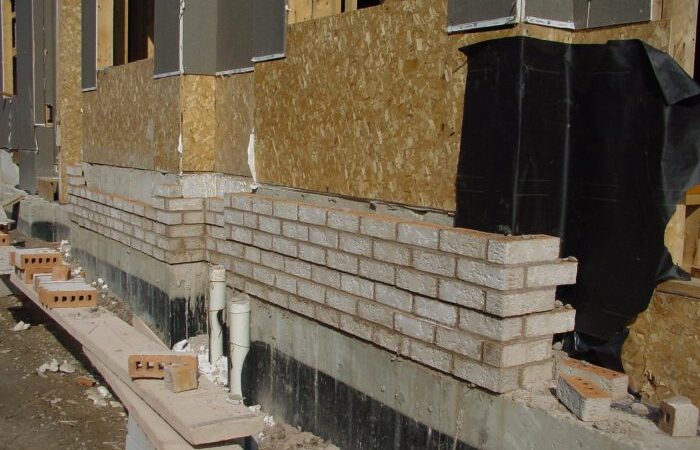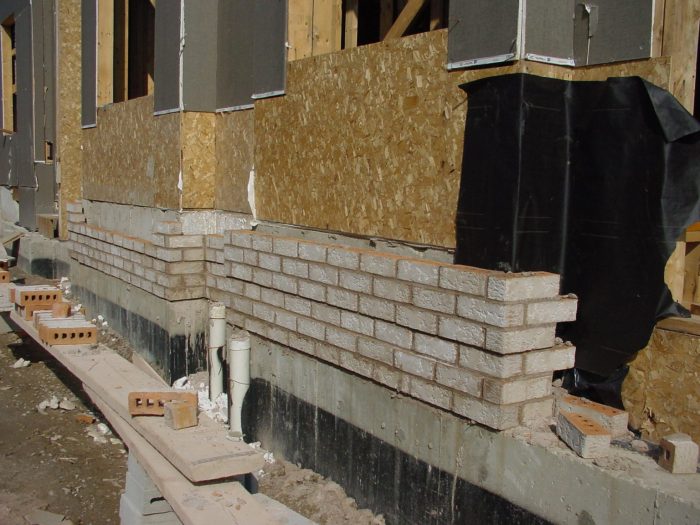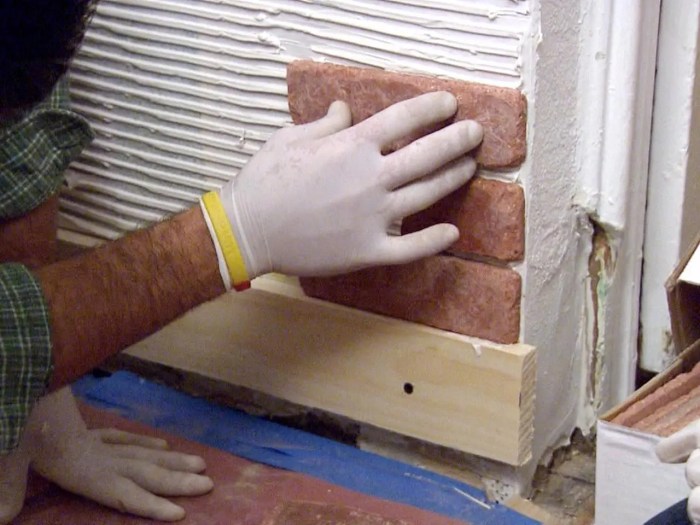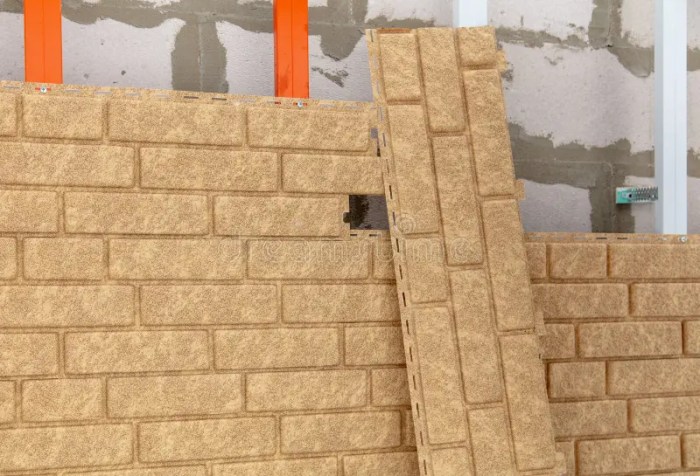Siding Over Brick A Home Renovation Guide

Siding over brick—it sounds simple, but this home improvement project offers a surprising array of considerations. From dramatically altering your home’s curb appeal to impacting its resale value and energy efficiency, covering brick with siding involves aesthetic, structural, financial, and even environmental factors. This guide navigates the complexities, helping you make informed decisions every step of the way.
We’ll explore the visual transformations possible with different siding materials and colors paired with various brick types. We’ll delve into the costs involved, including materials, labor, and permits, comparing siding over brick to alternative exterior cladding solutions. Crucially, we’ll address the practical aspects of installation, including surface preparation, overcoming challenges like uneven brickwork, and choosing the right fasteners. Finally, we’ll discuss the long-term implications for your home’s value and its environmental footprint.
Aesthetics and Curb Appeal

Source: baileylineroad.com
Adding siding over brick can dramatically alter a home’s appearance, sometimes for the better, sometimes not. The success hinges on careful consideration of the existing brick, the chosen siding, and the overall architectural style of the house. Getting it right can boost curb appeal significantly; getting it wrong can detract from the home’s value and charm.
Visual Impact of Siding Over Brick on Different Architectural Styles
The visual effect of siding over brick varies greatly depending on the architectural style of the house. A Victorian home might look charming with clapboard siding, while a Ranch-style house could benefit from a more modern, sleek siding material. The key is to maintain a cohesive aesthetic. Below is a table illustrating some examples:
| Architectural Style | Siding Material | Brick Color | Overall Impression |
|---|---|---|---|
| Victorian | Wood Clapboard (painted white) | Dark Red | Classic, charming, and updated |
| Ranch | Fiber Cement (grey) | Light Beige | Modern, clean, and contemporary |
| Colonial | Vinyl (cream) | Light Brown | A traditional, subtle update |
| Craftsman | Stone Veneer (to complement brick) | Russet | Harmonious, rustic, upscale |
Comparison of Siding Over Brick with Other Cladding Options
Siding over brick offers a different aesthetic compared to other exterior cladding options. Stone veneer, for instance, provides a more rustic and substantial look, often associated with higher-end homes. Stucco offers a smoother, more contemporary feel, and can be textured for added visual interest. Siding over brick allows for a more versatile update, potentially offering cost savings compared to full-scale stone or stucco applications, but the overall effect depends heavily on the selection of siding material and color. For example, a well-chosen siding might create a softer, more approachable look than the original brick, whereas a poorly chosen option could make the home look dated or disjointed.
Complementing and Clashing Siding and Brick Colors
The color and texture of the siding must complement the existing brick to achieve a visually pleasing result. Light-colored siding generally works well with darker brick, softening the overall look and creating contrast. Conversely, darker siding on lighter brick can create a dramatic, modern feel, but can also look harsh if not carefully considered. Textured siding, such as wood or stone-look vinyl, can add visual interest and depth, preventing the home from appearing flat or monotonous. For example, a warm, earthy-toned brick might be beautifully complemented by a light beige or taupe siding with a subtle wood grain texture, whereas bright blue siding on the same brick might look jarring and discordant. The goal is harmony, not competition. Avoid overly contrasting colors unless you are aiming for a very specific, modern aesthetic.
Cost and Material Considerations: Siding Over Brick
Adding siding over brick is a significant home improvement project, and understanding the associated costs is crucial for effective budgeting. The overall expense will depend on several factors, including the size of your home, the type of siding chosen, labor rates in your area, and the complexity of the installation. Let’s break down the key cost components.
Cost Breakdown for Siding Over Brick
A realistic budget needs to account for materials, labor, and permits. These costs can vary widely depending on location and project specifics. It’s always best to get multiple quotes from reputable contractors.
- Materials: The cost of siding materials varies greatly depending on the type chosen (vinyl, fiber cement, wood, etc.). For example, vinyl siding is generally the most affordable, while fiber cement and wood siding are significantly more expensive. You’ll also need underlayment, flashing, fasteners, and trim, all adding to the overall material cost. Expect to pay anywhere from $2 to $20+ per square foot for materials alone, depending on the chosen siding type and quality.
- Labor: Labor costs are typically calculated per square foot and depend on the contractor’s rates and the complexity of the job. Factors like the presence of intricate architectural details or difficult-to-access areas can increase labor costs. Expect to pay anywhere from $2 to $10+ per square foot for labor, potentially more in high-demand areas.
- Permits: Building permits are required in most jurisdictions before starting any exterior renovation. The cost of permits varies depending on location and the scope of the project. It’s wise to budget an additional $500-$2000 or more for permits and inspections.
Siding Material Longevity and Maintenance
The longevity and maintenance requirements of different siding materials significantly impact the overall cost-effectiveness of the project. Choosing a durable, low-maintenance material can save money in the long run.
- Vinyl Siding: Vinyl siding is relatively low-maintenance, requiring only occasional cleaning. It typically lasts 20-30 years. However, it can be prone to damage from impact and extreme temperatures.
- Fiber Cement Siding: Fiber cement siding is more durable and fire-resistant than vinyl, lasting 50 years or more. It requires more maintenance, including periodic painting or staining.
- Wood Siding: Wood siding offers a classic look but requires significant maintenance, including regular painting, staining, and potential repairs due to rot or insect damage. Its lifespan can vary greatly depending on the type of wood and the level of maintenance.
Cost-Effectiveness Compared to Other Options
The cost-effectiveness of siding over brick compared to other renovation options depends on several factors. For example, if your brick is severely damaged or deteriorated, repairing or replacing it might be more expensive than adding siding. Conversely, if your brick is in good condition and you simply want a change in aesthetics, the cost of siding might outweigh the benefits. Other options, such as painting the brick, represent a much lower-cost alternative but may not achieve the desired transformation. A thorough cost-benefit analysis, comparing the cost of siding to other renovation options, is essential before proceeding. For instance, a comprehensive brick repair might cost $10-20 per square foot, whereas siding might fall within a similar range, but offer additional insulation benefits. In cases where significant brick repair is needed, siding might be the more economical choice.
Structural and Practical Aspects

Source: remodelingcosts.org
Installing siding over brick presents unique structural and practical considerations. Proper preparation is key to a successful and long-lasting installation, ensuring both the aesthetic appeal and the structural integrity of your home. Ignoring these steps can lead to problems ranging from cosmetic flaws to serious structural damage down the line.
Preparing brick surfaces for siding is crucial for ensuring a strong bond and preventing future problems. Moisture is a significant concern; brick is porous and can absorb water, leading to mold, mildew, and ultimately, damage to both the brick and the siding. Before installation, the brick surface needs to be thoroughly cleaned to remove loose mortar, dirt, and any efflorescence (white, powdery deposits). Addressing any existing cracks or damaged areas in the brick is also vital. These repairs might involve filling cracks with appropriate mortar and letting them cure completely before proceeding. A thorough cleaning, often involving pressure washing (carefully to avoid damage), is followed by allowing the brick to completely dry. A primer designed for masonry surfaces can enhance adhesion and provide a barrier against moisture penetration.
Brick Surface Preparation for Siding Installation
Proper preparation ensures a lasting bond between the siding and the brick. This involves several key steps: First, a thorough cleaning removes loose debris and efflorescence. Next, any damaged brickwork must be repaired using compatible mortar. Allow ample drying time after cleaning and repairs. Finally, applying a masonry primer enhances adhesion and protects against moisture. Failing to properly prepare the brick can lead to premature siding failure due to moisture intrusion and poor adhesion. For instance, if you skip priming, the siding might peel or crack more easily as the brick absorbs moisture and expands and contracts.
Addressing Uneven Brick Surfaces and Existing Damage
Uneven brick surfaces are common and can pose challenges for siding installation. Minor irregularities can often be accommodated with the use of furring strips, and thin strips of wood attached to the brick to create a more uniform surface for the siding. Significant unevenness might require more extensive preparation, such as the application of a leveling compound before siding installation. Existing damage to the brick, such as cracks or holes, should be repaired before siding is installed. Using a suitable patching compound that matches the brick’s color is essential for a seamless finish. For example, a large crack left unaddressed could compromise the structural integrity of the wall, leading to siding damage.
Fastener Selection and Installation Techniques
The choice of fasteners and installation techniques depends heavily on the type of siding being used. Vinyl siding, for example, often utilizes nails or staples, while fiber cement siding might require screws for a more secure hold. Regardless of the siding material, it’s crucial to select fasteners that are appropriate for both the siding and the brick substrate. For instance, using galvanized nails or stainless steel screws helps prevent corrosion and ensures longevity. Over-driving fasteners can damage the siding while under-driving them can compromise their holding power. Proper installation techniques will vary depending on the siding material; always consult the manufacturer’s instructions for specific guidance. For example, vinyl siding often requires expansion gaps to account for thermal expansion and contraction. Ignoring this could lead to buckling or warping.
Impact on Home Value and Resale
Siding over brick is a significant exterior alteration that can impact your home’s value, both positively and negatively. The effect depends heavily on factors like the quality of the siding, the overall condition of the house, local market trends, and the perception of potential buyers. A poorly executed job can drastically reduce value, while a high-quality installation might offer some benefits.
The effect of siding over brick on resale value is complex and not easily summarized with a simple “yes” or “no.” Many factors influence how potential buyers perceive this modification. Some may view it as an improvement, masking outdated brick or protecting it from the elements. Others might see it as a sign of hidden problems or a cheap fix.
Buyer Perceptions of Siding Over Brick
Potential buyers’ opinions are shaped by several key factors. A high-quality, professionally installed siding job using durable, attractive materials will generally be viewed more favorably than a cheap, hastily done job that looks unfinished or poorly maintained. The overall aesthetic appeal is crucial; siding that complements the home’s style and architectural features will likely increase its attractiveness to potential buyers while clashing siding can detract from the curb appeal. The condition of the underlying brick is also a significant consideration. If the brick is damaged or deteriorated, siding might be seen as a necessary repair. Conversely, if the brick is in good condition, covering it with siding might be perceived as unnecessary and even wasteful. Finally, location plays a significant role. In some neighborhoods, siding over brick might be common and accepted, while in others, it might be viewed as unusual or undesirable.
Resale Value Comparison: Siding vs. Original Brick
Directly comparing the resale value of homes with siding over brick to homes with original brick exteriors requires considering several variables. Location is paramount; in areas where siding is prevalent, the impact on value might be minimal, while in areas where brick is highly valued, it could be more significant. Market trends also play a role; a strong seller’s market might lessen the negative impact of siding over brick, while a buyer’s market might amplify it. For example, a home in a suburban area with a large number of homes featuring vinyl siding might not experience a significant value decrease from siding over brick compared to a home in a historic district where original brick is highly valued. The overall condition of the home is another critical factor. A well-maintained home with siding over brick might still sell well, especially if the siding is high-quality and complements the property’s aesthetics. However, a poorly maintained home with shoddy siding will likely sell for less regardless of the underlying brick. Finally, the type of siding matters; high-end materials like fiber cement or engineered wood siding can potentially improve the perceived value, while lower-cost options like vinyl might not.
Environmental Considerations
Choosing siding over brick involves several environmental considerations, from the raw materials used to the eventual disposal of the materials. Understanding the environmental impact of different siding options is crucial for making an informed and sustainable decision for your home renovation. This section will explore the lifecycle environmental impact of various siding materials and their influence on your home’s energy efficiency.
Environmental Impact of Siding Materials, Siding over brick
The environmental impact of siding materials varies significantly depending on their source, manufacturing process, transportation needs, and end-of-life management. For instance, vinyl siding, while often inexpensive, relies on petroleum-based plastics, contributing to greenhouse gas emissions during production and disposal. Wood siding, especially sustainably harvested wood, can have a lower carbon footprint but requires careful consideration of the forestry practices involved. Fiber cement siding, a composite material, often has a higher embodied energy due to the manufacturing process but offers loa nger lifespan, reducing the frequency of replacements. Metal sidings, like aluminum or steel, are recyclable but have high energy requirements in their production. Each material presents a unique environmental profile.
Energy Efficiency Comparison: Siding over Brick vs. Exposed Brick
Homes with exposed brick often benefit from superior thermal mass, meaning they retain heat in winter and stay cooler in summer. However, adding siding can improve energy efficiency by creating an additional layer of insulation, especially if the siding system includes proper insulation. The extent of energy savings depends heavily on the type of siding and the insulation used.
| Siding Material | R-value (Approximate) | Energy Savings (Estimate) |
|---|---|---|
| Vinyl Siding (with typical insulation) | R-4 to R-6 | 5-10% reduction in heating/cooling costs, depending on climate and existing insulation. |
| Wood Siding (with proper insulation) | R-3 to R-5 (depending on thickness and type of wood) | Similar to vinyl, with potential for higher savings if thicker wood is used and high-quality insulation is installed. |
| Fiber Cement Siding (with insulation) | R-value depends heavily on the insulation installed behind it; can achieve R-10 or higher with proper installation. | Potentially significant savings (10-20% or more) depending on the overall insulation system. |
| Metal Siding (with insulation) | R-value depends on insulation; can achieve good levels of insulation with proper installation. | Significant potential for energy savings, similar to fiber cement, depending on the insulation system. |
| Exposed Brick (no siding) | R-value varies greatly depending on brick thickness and type of mortar; generally lower than sided options with insulation. | Lower energy efficiency compared to options with added insulation. |
*Note: R-values and energy savings are approximate and can vary depending on factors like climate, installation quality, and existing home insulation.* These figures are based on averages found in industry reports and energy efficiency studies. Actual savings may differ.
Sustainability of Siding Options and Carbon Footprint
The sustainability of siding choices extends beyond just the energy efficiency of the finished product. Consider the sourcing of materials – sustainably harvested wood has a far lower carbon footprint than wood from unsustainable forestry practices. Recycled content in materials like vinyl or composite siding can also significantly reduce the environmental impact. The lifespan of the siding is another critical factor; longer-lasting materials reduce the need for frequent replacements and associated waste. Finally, the recyclability or ease of disposal of the siding at the end of its life should be considered. For example, choosing a siding material that can be easily recycled or repurposed minimizes landfill waste and contributes to a lower overall carbon footprint for the home renovation project. For instance, a home using reclaimed wood siding would have a significantly smaller carbon footprint compared to one using newly manufactured vinyl.
Final Wrap-Up

Source: dreamstime.com
Ultimately, the decision to install siding over the brick is a personal one, weighing the aesthetic enhancements, financial investment, and long-term implications. This guide has provided a comprehensive overview of the key considerations, empowering you to make an informed choice that best suits your home, budget, and lifestyle. Remember to consult with professionals for personalized advice tailored to your specific project and local regulations. A well-planned approach ensures a successful transformation that enhances your home’s beauty and value for years to come.
Popular Questions
Can I install siding over the brick myself?
While possible for some simpler siding types, professional installation is generally recommended. Brick surfaces can be unpredictable, and improper installation can lead to costly repairs.
How long does siding over brick last?
Lifespan varies greatly depending on the siding material chosen. Vinyl siding might last 20-30 years, while fiber cement can last 50 years or more. Proper installation significantly impacts longevity.
Does siding over brick reduce my home’s value?
Not necessarily. If done tastefully and with high-quality materials, it can enhance curb appeal and increase value. However, poorly executed work can detract from value.
What about potential mold or moisture issues?
Proper preparation is crucial. Addressing any existing moisture problems in the brick before siding installation is vital to prevent mold and rot. Adequate ventilation is also key.
Will siding over brick impact my home insurance?
It’s advisable to inform your insurance provider about the renovation. While it shouldn’t automatically increase premiums, the type of siding used might influence rates.
Comments are closed.